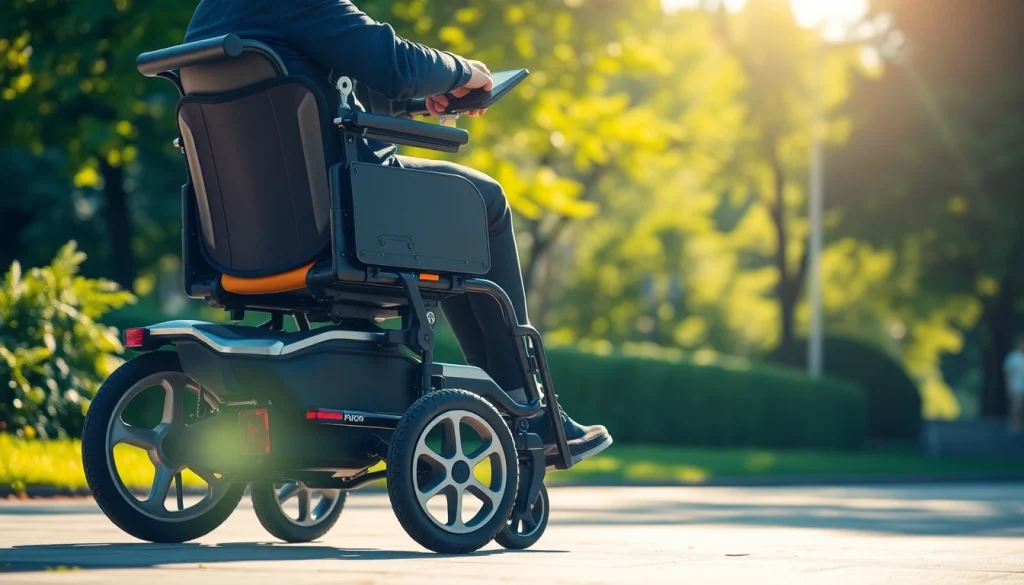Understanding Power Wheelchairs
What is a Power Wheelchair?
A power wheelchair, also known as an electric wheelchair, is a mobility device that is powered by batteries. It is designed to assist individuals with mobility impairments, allowing them greater independence and movement. Unlike manual wheelchairs that require physical effort to propel, power wheelchairs are equipped with motors that enable users to navigate various terrains effortlessly. This technology not only enhances mobility but also improves the overall quality of life for individuals requiring assistance. You can learn more about the different types of power wheelchairs by visiting Power wheelchair resources.
Types of Power Wheelchairs
Power wheelchairs come in several types, each tailored to meet specific user needs and environments:
- Standard Power Wheelchairs: Suitable for indoor and limited outdoor use, these models are simple in design and provide basic functionalities.
- Heavy Duty Power Wheelchairs: Designed for larger individuals, these models have reinforced structures and enhanced weight capacities, making them suitable for rugged outdoor environments.
- Portable Power Wheelchairs: Lightweight and foldable, portable power wheelchairs are designed for easy transport and travel, making them ideal for users on the go.
- Reclining Power Wheelchairs: These wheelchairs offer the ability to recline the backrest and elevate the footrests, providing comfort for extended periods of use, particularly useful for individuals with certain medical conditions.
- Standing Power Wheelchairs: A unique option that allows users to stand, facilitating better engagement with their surroundings and enhancing health through improved circulation.
Key Features to Consider
When selecting a power wheelchair, several key features should be considered to ensure the device meets the user’s needs:
- Control System: Most power wheelchairs feature joystick controls, but some models may offer alternative control systems, such as sip-and-puff or head control, suitable for individuals with limited hand movement.
- Seating Comfort: Look for adjustable seating with options for cushions or supports that enhance posture and comfort during extended use.
- Battery Life: Consider models that offer robust battery life and the convenience of battery replacement, ensuring the power wheelchair can support daily activities without frequent recharging.
- Weight Capacity: Always check the weight limits of the wheelchair to ensure safety and performance for the user.
- Customizability: Many power wheelchairs can be tailored with additional features such as different seating options, armrest styles, and accessories like storage compartments.
Benefits of Using a Power Wheelchair
Enhanced Independence and Mobility
One of the most significant benefits of power wheelchairs is the independence they provide users. With the ability to navigate various environments—be it at home, in public spaces, or during travel—individuals utilizing power wheelchairs can reclaim daily activities and reduce dependence on caregivers. This newfound mobility leads to increased participation in social events, outdoor activities, and overall engagement with life, enhancing mental well-being.
Comfort Features That Enhance User Experience
Comfort is paramount for the usability of wheelchairs. Power wheelchairs often come equipped with features that prioritize comfort. These may include ergonomic design, adjustable seating, and customizable controls, allowing users to find their optimal position and minimize discomfort. Additionally, features such as suspension systems can significantly enhance the ride quality, making travel over uneven surfaces more pleasant.
Comparing Cost-Effectiveness with Manual Wheelchairs
While the upfront cost of a power wheelchair is typically higher than that of a manual wheelchair, the long-term benefits can justify the investment. Power wheelchairs may alleviate the need for caregiver assistance, thus reducing long-term care costs. Moreover, their capability to navigate a range of environments efficiently can promote engagement in activities that manual wheelchairs might make difficult, ultimately leading to better health outcomes.
Choosing the Right Power Wheelchair
Assessing Your Unique Needs
Selecting the right power wheelchair begins with understanding your specific needs. Factors such as the user’s physical condition, lifestyle, and intended usage play critical roles in the decision-making process. It is essential to consider environments in which the wheelchair will be used, such as indoors, outdoors, or both, and whether the user requires additional support features for health issues.
Professional Evaluations and Recommendations
Consultation with healthcare professionals, including occupational therapists, can provide valuable insights into the most suitable power wheelchair options. These experts can assess individual needs, considering factors like strength, mobility levels, and health concerns, to recommend the best wheelchair that enhances safety and efficacy.
Customizing Your Power Wheelchair
Customization is a vital step in ensuring user satisfaction with a power wheelchair. Many manufacturers offer options that allow users to modify specifications to their preferences, such as seating, control types, and added features like lights or storage compartments. Engaging with a dealer who specializes in mobility assessments and customization can enhance the fitting experience, ensuring the wheelchair adapts to individual requirements.
Maintaining Your Power Wheelchair
Routine Maintenance Tips for Longevity
To ensure the longevity and optimal performance of a power wheelchair, routine maintenance is essential. Regular checks on components such as brakes, motors, and wheels help to identify wear and tear early. Users should also ensure that the wheelchair is clean to prevent damage from dirt and debris. Following manufacturer’s guidelines regarding maintenance schedules will enhance the device’s lifespan.
Finding Reliable Repair Services
Knowing where to obtain repairs and service is crucial for power wheelchair users. Researching and identifying local service providers who specialize in mobility equipment repairs helps ensure timely service. Additionally, consider providers who offer warranties or guarantees on their work, giving users peace of mind that their wheelchairs are being handled by knowledgeable professionals.
Battery Care and Replacement
The battery is a critical component of power wheelchairs that requires special attention. Users should be familiar with their wheelchair’s battery type and follow guidelines for optimal charging practices, such as avoiding complete depletion and utilizing smart chargers whenever possible. Regular battery maintenance checks, along with timely replacement of batteries, are necessary to ensure reliability and prevent unexpected breakdowns.
Future of Power Wheelchairs
Emerging Technologies in Mobility Aids
The future of power wheelchairs is bright, with ongoing advancements in technology enhancing their functionality and user experience. Innovations such as advanced sensors, obstacle detection systems, and even AI-powered navigation tools are making power wheelchairs safer and easier to use. These technologies are designed to simplify the user’s experience while providing more precise control in a variety of environments.
Impact of Smart Features on Power Wheelchairs
Smart technology is revolutionizing mobility aids, including power wheelchairs. Features like smartphone connectivity, automated diagnostic tools, and customizable settings are becoming increasingly common. These innovations not only enhance usability but also enable users to monitor their wheelchair’s performance and maintain it more efficiently.
Advancements in Design for Accessibility
Design advancements are also shaping the landscape of power wheelchairs. Innovative designs focus on improving aesthetics while emphasizing functionality and accessibility. Lightweight materials and compact designs for easier transport are key trends, alongside enhancements to provide increased stability and support for users with diverse needs. Future designs are expected to prioritize user engagement and comfort as mobility aid technologies continue to evolve.



